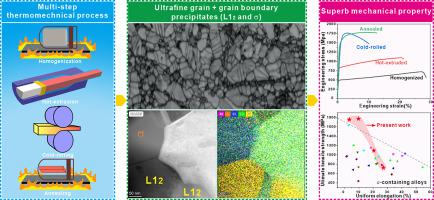当前位置:
X-MOL 学术
›
Int. J. Plasticity
›
论文详情
Our official English website, www.x-mol.net, welcomes your feedback! (Note: you will need to create a separate account there.)
Synergistic grain boundary engineering for achieving strength-ductility balance in ultrafine-grained high-Cr-bearing multicomponent alloys
International Journal of Plasticity ( IF 9.4 ) Pub Date : 2024-05-03 , DOI: 10.1016/j.ijplas.2024.103992 Xiaoming Liu , Kaikai Song , Zongde Kou , Jianhong Gong , Xiangyan Chen , Qingwei Gao , Hui Sun , Pingping Liu , Ruitao Qu , Lina Hu , Zequn Zhang , Parthiban Ramasamy , Zengqian Liu , Zhenjun Zhang , Feng Liu , Zhefeng Zhang , Jürgen Eckert
International Journal of Plasticity ( IF 9.4 ) Pub Date : 2024-05-03 , DOI: 10.1016/j.ijplas.2024.103992 Xiaoming Liu , Kaikai Song , Zongde Kou , Jianhong Gong , Xiangyan Chen , Qingwei Gao , Hui Sun , Pingping Liu , Ruitao Qu , Lina Hu , Zequn Zhang , Parthiban Ramasamy , Zengqian Liu , Zhenjun Zhang , Feng Liu , Zhefeng Zhang , Jürgen Eckert

|
Precipitation strengthening is a crucial strategy for ensuring the overall performance of conventional and multicomponent alloys to meet industrial demands. However, the mechanical properties of high-Cr-bearing alloys are often compromised by brittle Cr-rich precipitates at grain boundaries (GBs), leading to severe embrittlement. In this work, a multi-step thermomechanical process is employed to regulate discontinuous dynamic recrystallization (DDRX) and static recrystallization, achieving an ultrafine-grained microstructure. This optimized approach simultaneously impedes the continuous precipitation of the ordered L1 nanocrystals within the matrix and actively encourages the synergistic discontinuous precipitations of submicron L1 and Cr-rich particles at GBs, thereby enhancing (yield) strength and high-temperature thermal stability. The ultrafine grains facilitate uniform plastic deformation, characterized by pronounced parallel dislocation slip and stacking faults (SFs) within face-centered cubic (fcc) grains, while second-direction slips, SFs, and Lomer-Cottrell (L-C) lock networks near GB precipitates greatly alleviate stress concentration. Critically, the submicron L1 particles enveloping precipitates at GBs also display plastic deformation via mechanical twinning and dislocations, effectively impeding rapid crack propagation along GBs. This research not only provides new insights into the ductility-strength balance in advanced alloys but also proposes a compelling route for optimizing biphasic precipitation, expanding the applicability of high-Cr multicomponent alloys.
中文翻译:

协同晶界工程实现超细晶粒高铬多元合金的强度-延展性平衡
沉淀强化是确保传统和多元合金的整体性能满足工业需求的关键策略。然而,高铬合金的机械性能常常受到晶界(GB)处脆性富铬析出物的影响,导致严重脆化。在这项工作中,采用多步热机械过程来调节不连续动态再结晶(DDRX)和静态再结晶,实现超细晶粒微观结构。这种优化的方法同时阻止了基体中有序 L1 纳米晶体的连续沉淀,并积极促进亚微米 L1 和富铬颗粒在 GB 处的协同不连续沉淀,从而提高(屈服)强度和高温热稳定性。超细晶粒促进均匀塑性变形,其特征是面心立方 (fcc) 晶粒内存在明显的平行位错滑移和堆垛层错 (SF),而晶界析出物附近有第二方向滑移、SF 和 Lomer-Cottrell (LC) 锁定网络大大缓解应力集中。至关重要的是,包围晶界处析出物的亚微米 L1 颗粒还通过机械孪生和位错表现出塑性变形,有效地阻止了裂纹沿晶界的快速扩展。这项研究不仅为先进合金的延展性-强度平衡提供了新的见解,而且还提出了一条优化双相析出、扩大高铬多元合金的适用性的引人注目的途径。
更新日期:2024-05-03
中文翻译:

协同晶界工程实现超细晶粒高铬多元合金的强度-延展性平衡
沉淀强化是确保传统和多元合金的整体性能满足工业需求的关键策略。然而,高铬合金的机械性能常常受到晶界(GB)处脆性富铬析出物的影响,导致严重脆化。在这项工作中,采用多步热机械过程来调节不连续动态再结晶(DDRX)和静态再结晶,实现超细晶粒微观结构。这种优化的方法同时阻止了基体中有序 L1 纳米晶体的连续沉淀,并积极促进亚微米 L1 和富铬颗粒在 GB 处的协同不连续沉淀,从而提高(屈服)强度和高温热稳定性。超细晶粒促进均匀塑性变形,其特征是面心立方 (fcc) 晶粒内存在明显的平行位错滑移和堆垛层错 (SF),而晶界析出物附近有第二方向滑移、SF 和 Lomer-Cottrell (LC) 锁定网络大大缓解应力集中。至关重要的是,包围晶界处析出物的亚微米 L1 颗粒还通过机械孪生和位错表现出塑性变形,有效地阻止了裂纹沿晶界的快速扩展。这项研究不仅为先进合金的延展性-强度平衡提供了新的见解,而且还提出了一条优化双相析出、扩大高铬多元合金的适用性的引人注目的途径。












































 京公网安备 11010802027423号
京公网安备 11010802027423号